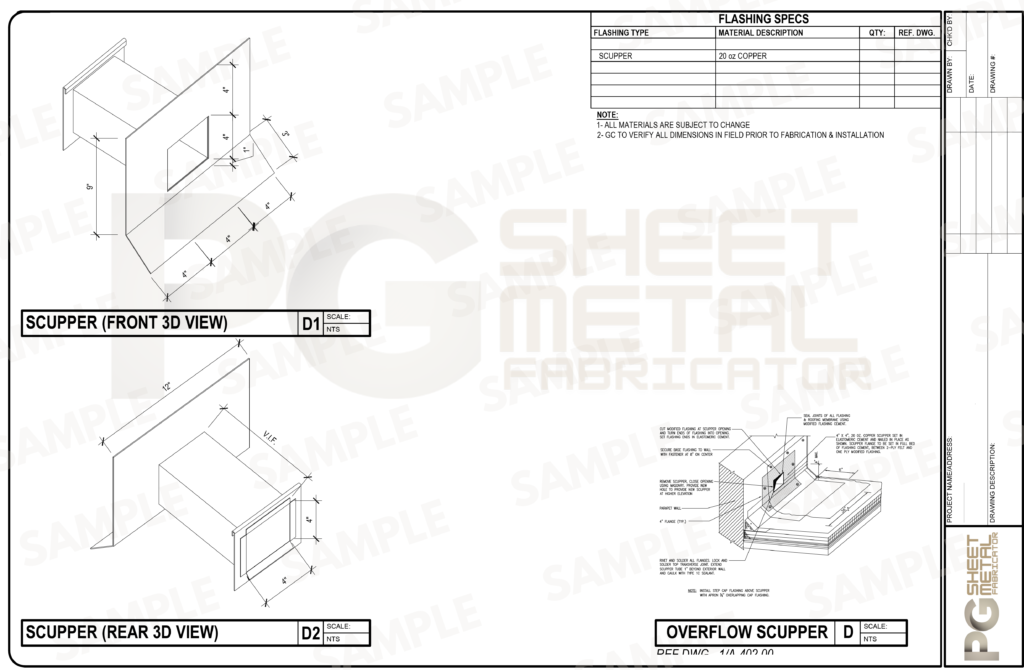
What Are Scuppers?
Scuppers are essential components in roof drainage systems, designed to direct water off a roof and prevent water accumulation. These small openings or drains are typically installed along the edge of a roof, allowing water to flow freely into the gutters, downspouts, or direct drainage systems. Scuppers are used in both commercial and residential roofing systems, particularly in flat or low-slope roofs, where proper water drainage is critical to avoid leaks, water damage, and structural issues.
Scuppers can be made from various materials, including metal, and are available in different shapes and sizes to accommodate the unique drainage needs of a building. They are often paired with other drainage elements, such as gutters, downspouts, and leader pipes, to create an effective and comprehensive roof drainage system.

Benefits of Scuppers
- Efficient Water Drainage: Scuppers provide a clear and direct path for water to exit the roof, preventing water buildup that can lead to leaks, mold growth, or structural damage.
- Prevents Water Damage: By ensuring that water flows properly off the roof, scuppers help protect the roof, walls, and foundation of a building from water-related damage.
- Easy Installation and Maintenance: Scuppers are relatively easy to install and maintain compared to other types of drainage systems, making them an ideal choice for both new construction and roof retrofitting.
- Versatile and Customizable: Scuppers come in a variety of materials, shapes, and sizes to suit different roofing systems and architectural styles, ensuring both functionality and aesthetic appeal.
- Cost-Effective: Scuppers are a budget-friendly solution for effective roof drainage, offering long-term performance and durability without the high installation costs of more complex systems.

Applications of Scuppers
- Flat Roofs: Scuppers are commonly used on flat or low-slope roofs, where they provide efficient water drainage and prevent pooling. These roofs are prone to water accumulation, and scuppers help channel the water away before it can cause damage.
- Commercial Buildings: In commercial and industrial settings, scuppers are essential for large, flat-roof systems that need to handle significant amounts of rainwater. Scuppers ensure that the roof’s drainage system functions properly, even during heavy rainfall.
- Residential Roofs: For residential properties with flat or low-pitch roofs, scuppers can be installed to help manage water runoff and maintain the roof’s structural integrity.
- Architectural Features: Scuppers are also used in decorative applications, such as in custom architectural designs where water features or unique drainage elements are integrated into the building’s overall aesthetic.
Materials for Scuppers
- Aluminum: Lightweight, corrosion-resistant, and easy to install, aluminum is a popular choice for scuppers, particularly in residential and commercial roofing applications.
- Copper: Copper scuppers are both durable and visually appealing, often used in high-end residential and commercial properties where aesthetics are as important as function.
- Stainless Steel: For high-strength, corrosion-resistant scuppers, stainless steel is ideal. These are often used in industrial settings where the durability of the material is paramount.
- Galvanized Steel: Galvanized steel scuppers are cost-effective and offer excellent durability in both residential and commercial installations.

How to Install Scuppers
- Identify Drainage Needs: Determine the appropriate size and placement of scuppers based on the size of the roof, the average rainfall in the area, and any other factors that might influence drainage needs.
- Prepare the Roof: Ensure the roof edge is clean and free of debris. Scuppers should be installed in areas where water will naturally flow off the roof.
- Install the Scupper Box: Attach the scupper box to the roof edge. This box will collect the water and direct it to the downspouts or drainage system.
- Seal the Edges: Use roofing sealant to ensure the edges of the scupper are watertight. This helps prevent leaks around the scupper and ensures proper drainage.
- Connect to Downspouts: Attach the scupper to the appropriate drainage system, such as a downspout or a direct discharge system. Make sure the water flows freely through the system and away from the building.
- Inspect Regularly: After installation, regularly inspect the scuppers for any blockages, debris, or damage that might affect their performance. Clean them as needed to ensure efficient water flow.
Why Choose PG Sheet Metal for Scuppers?
At PG Sheet Metal, we specialize in crafting high-quality, custom scuppers that provide efficient and reliable water drainage for your roofing systems. Whether you’re working on a commercial project, residential property, or custom architectural design, we offer scuppers in a range of materials, including aluminum, copper, stainless steel, and galvanized steel, to meet your specific needs.
Our scuppers are designed for durability, easy installation, and long-term performance, ensuring that your roof remains protected from water damage. With expert craftsmanship and attention to detail, PG Sheet Metal ensures that your scuppers will perform effectively and enhance the overall functionality of your roofing system.
Contact Us Today
For premium custom scuppers designed to meet your roofing system’s needs, PG Sheet Metal is your trusted partner. Visit us at PG Sheet Metal or call 917-719-3513 to learn more about our metal solutions and request a quote.



